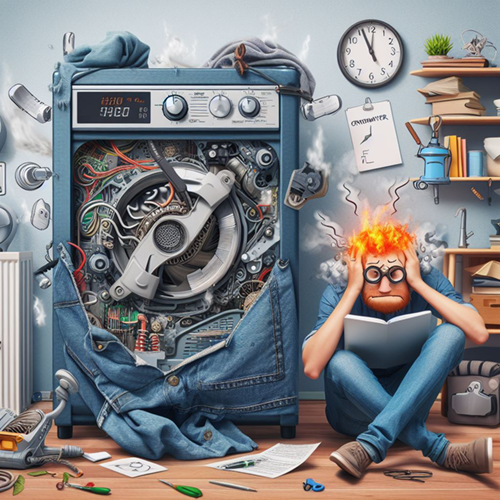When you’re in the midst of your laundry routine, there’s nothing more frustrating than having your dryer unexpectedly shut off before your clothes are adequately dry. Not only does this disrupt your daily chores, but it can also be a signal of an underlying problem with your dryer. Some times there is situation when you need professional miele dryer repair but if you want it diy repair understanding the reasons for premature dryer shut-off and learning how to resolve the issue can save you both time and money.
Common Reasons for Early Dryer Shut-Off
Before diving into the troubleshooting and repair process, it’s essential to comprehend the common reasons behind your dryer shutting off too soon. These are the typical culprits:
Overheating
- Dryers are designed with safety mechanisms to prevent overheating, and for a good reason. Overheating can pose a significant fire hazard in your home. If your dryer’s internal temperature rises to dangerous levels, the safety mechanisms will kick in, causing an automatic shut-off. This is a vital feature to protect your household and property from potential fires.
Blocked Ventilation
- Your dryer’s ventilation system is like its respiratory system. If it’s clogged or blocked, it can’t breathe properly. When airflow is restricted, heat accumulates within the dryer, and the temperature can soar to unsafe levels. To prevent overheating, your dryer’s safety systems initiate a shut-off. Regularly inspecting and cleaning your dryer’s ventilation is crucial not only for preventing early shut-off but also for preserving the appliance’s overall efficiency.
Faulty Sensors
- Modern dryers come equipped with advanced moisture and temperature sensors. These sensors are designed to gauge the moisture levels in your clothes and the internal temperature of the dryer. When they function correctly, they ensure that your laundry dries efficiently and safely. However, if any of these sensors malfunction, they might inaccurately detect the moisture levels, prematurely ending the drying cycle. This not only leaves your clothes damp but also disrupts the entire drying process.
Excessive Lint Buildup:
- While cleaning the lint filter after every cycle is a good practice, sometimes lint finds its way into the deeper corners of your dryer. This buildup can obstruct airflow, causing the appliance to overheat. To mitigate this risk, dryers have safety mechanisms that initiate a shut-off when they sense excessive heat. Clearing this lint buildup, not just from the filter but also from the internal components and ventilation, is essential to prevent both early shut-off and reduce the risk of lint-related fires.
Understanding these common reasons for early dryer shut-off is the first step in ensuring your dryer runs smoothly and efficiently. With proper maintenance and timely troubleshooting, you can avoid unnecessary disruptions in your laundry routine and extend the life of your appliance.
Step-by-Step Troubleshooting
Now, let’s go through the step-by-step process of troubleshooting and resolving the issue:

1. Step: Check for Proper Ventilation:
- The first and most crucial step is to ensure that your dryer’s venting system is clear of obstructions and that the air can flow freely. Start by inspecting the exterior vent for any visible blockages. Then, detach the vent from the dryer and check both ends for lint buildup. A clean ventilation system is vital to prevent overheating.
2. Step: Clean the Lint Filter
- Always start with the basics. A clogged lint filter can restrict airflow and lead to overheating. Remember to clean it after every drying cycle to maintain optimal dryer performance.
3. Step: Inspect the Thermostat:
- Test the thermostat to make sure it’s functioning correctly. To do this, you can use a multimeter to check for continuity. A malfunctioning thermostat might need replacement. If you are unsure how to perform this test, it’s recommended to seek professional assistance to avoid any risks.
4. Step: Examine the Moisture Sensors:
- Your dryer relies on moisture sensors to gauge the dampness of your laundry. If these sensors are damaged or covered in lint, they may not function accurately, causing your dryer to shut off prematurely. Clean the sensors gently to remove any dirt or lint buildup. Refer to your dryer’s manual for the precise location of these sensors.
5. Step: Test the Heating Element:
- A defective heating element can lead to overheating issues. To check its functionality, you can use a multimeter to ensure it’s working correctly. If it’s not heating up as it should, replacing the heating element may be necessary. Be cautious when handling the heating element, as it can become very hot.
6. Step: Evaluate the Control Board:
- In some cases, problems can be traced back to a malfunctioning control board. Inspect the control board for any visible signs of damage, burnt components, or loose connections. If you find any issues, consider consulting a professional technician or replacing the control board, as this component is essential for the operation of your dryer.
Maintenance Tips for Your Dryer
To prevent premature shut-off and ensure your dryer works efficiently, consider these maintenance tips:
- Regular Cleaning and Maintenance: Clean the lint filter after each cycle, and periodically clean the venting system to ensure proper airflow.
- Check Ventilation: Ensure your dryer is properly ventilated and that the venting system is clear of debris.
- Avoid Overloading: Overloading your dryer can lead to inefficient drying and overheating issues.
- Follow Manufacturer’s Instructions: Always adhere to the manufacturer’s guidelines for usage and maintenance.